
JMIR Medical Informatics
Scope & Guideline
Navigating the Future of Health Systems with Insightful Research
Introduction
Aims and Scopes
- Health Data Management and Interoperability:
The journal explores methodologies and technologies that enhance the management and interoperability of health data, including electronic health records (EHR) integrations and standards like FHIR. - Artificial Intelligence in Healthcare:
A significant focus on the application of AI, including machine learning and natural language processing, to improve diagnostic accuracy, patient outcomes, and operational efficiencies in healthcare settings. - Patient-Centered Innovations:
Research highlights the development of tools and systems that empower patients, such as mobile health applications and telehealth solutions, to enhance engagement and self-management of health. - Clinical Decision Support Systems:
The journal covers the design, implementation, and evaluation of clinical decision support systems that aid healthcare providers in making informed decisions based on real-time data. - Public Health and Epidemiology:
Research includes studies utilizing health informatics to address public health challenges, improve disease surveillance, and manage health crises, particularly in the context of COVID-19. - Ethics and Policy in Health Informatics:
The journal discusses ethical considerations, policy implications, and governance related to health data usage, privacy, and the impact of technology on healthcare delivery.
Trending and Emerging
- Generative AI Applications:
Research on the applications of generative AI, particularly in medical documentation and patient interactions, is gaining traction as healthcare seeks to leverage AI for efficiency and accuracy. - Data Quality and Integrity:
There is an increasing emphasis on the quality and integrity of health data, with studies focusing on methodologies to evaluate and enhance data quality for better clinical outcomes. - Predictive Analytics and Risk Assessment:
Emerging themes involve the use of predictive analytics to assess risks and outcomes in patient populations, particularly in chronic disease management and acute care settings. - Integration of Social Determinants of Health (SDOH) in Clinical Practice:
Research is increasingly addressing how SDOH are integrated into health informatics systems to improve patient care and outcomes. - Patient-Generated Health Data (PGHD):
The role of PGHD in clinical decision-making and patient engagement is becoming a prominent theme, highlighting the importance of incorporating patient insights into care models. - Cross-Country Health Informatics Studies:
There is a growing trend towards comparative studies across different countries, exploring how diverse healthcare systems implement informatics solutions.
Declining or Waning
- Traditional Clinical Informatics Frameworks:
There is a noticeable reduction in studies focused on traditional clinical informatics frameworks, as the field shifts towards more innovative and technology-driven approaches. - Hardware-Driven Innovations:
Research related to hardware advancements in healthcare technology, such as specific medical devices, has seen a decline, with a greater emphasis now on software solutions and data analytics. - General Health IT Adoption Studies:
Studies focusing solely on the adoption of health IT without specific applications or innovations are less common, reflecting a shift towards more applied and outcome-oriented research. - Standalone Telehealth Evaluations:
As telehealth becomes integrated into broader health informatics systems, standalone evaluations of telehealth efficacy are becoming less frequent. - Single-Center Studies:
There is a waning interest in single-center studies, with a trend towards multicenter collaborations and larger-scale analyses that provide more generalizable results.
Similar Journals
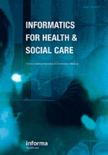
Informatics for Health & Social Care
Fostering collaboration between health and technology.Informatics for Health & Social Care is a leading journal published by Taylor & Francis Inc, dedicated to the intersection of health informatics and social care. With a strong emphasis on advancing knowledge in the fields of health information management and nursing, this journal has established itself as a vital resource for researchers and professionals seeking to explore innovative applications of informatics to improve patient outcomes and streamline healthcare delivery. Recognized for its influential contributions, it currently holds a Q2 ranking in both Health Informatics and Health Information Management, as well as a prestigious Q1 ranking in Nursing (miscellaneous) for 2023, signifying its critical role within the academic community. The journal is accessible for open access viewing, fostering a broader dissemination of research findings. Released continuously since 1976, it stands as a testament to the evolving landscape of health informatics, addressing pertinent issues and facilitating discussions that shape practices in health and social care delivery.

ACM Transactions on Management Information Systems
Connecting Scholars and Practitioners in Information SystemsACM Transactions on Management Information Systems is a prestigious journal published by the Association for Computing Machinery, dedicated to advancing the interdisciplinary field of management information systems. With an impact factor that reflects its esteemed position within the academic community, it has achieved remarkable rankings, including being classified as Q1 in Computer Science (miscellaneous) and Q2 in Management Information Systems as of 2023. Researchers and practitioners alike recognize this journal for its rigorous peer-reviewed articles that explore innovations, methodologies, and applications in information systems management, ensuring its relevance in today's ever-evolving digital landscape. The journal offers a vital platform for sharing cutting-edge research, supported by the publisher's commitment to excellence in the field, making it an essential resource for scholars and professionals aiming to stay at the forefront of management information systems research.

Health Information Management Journal
Elevating Health Leadership with Insightful ResearchHealth Information Management Journal, published by SAGE Publications Inc., is a premier academic resource dedicated to the intersection of health informatics, health information management, health policy, and leadership in health services. With an impressive track record since its inception in 2002, this journal steadily contributes to scholarly dialogue and innovation in the field, holding a commendable Q2 ranking in Health Informatics, Health Information Management, and Health Policy, and a distinguished Q1 ranking in Leadership and Management as of 2023. As a critical platform for researchers, professionals, and students, it fosters the dissemination of cutting-edge research and practical applications, bridging the gap between theory and practice. Though not an open-access journal, it provides a wealth of subscription-based resources that are invaluable for advancing knowledge and improving health systems globally. The journal’s commitment to high-quality, peer-reviewed content ensures that it remains a vital tool for anyone invested in the future of health information management.
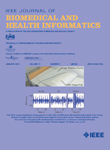
IEEE Journal of Biomedical and Health Informatics
Empowering Collaboration for a Healthier TomorrowIEEE Journal of Biomedical and Health Informatics is a premier publication dedicated to advancing the field of biomedical and health informatics. Published by the esteemed IEEE-Inst Electrical Electronics Engineers Inc, this journal boasts a notable impact within various disciplines, ranking in the top quartile (Q1) across key categories such as Biotechnology, Computer Science Applications, Electrical and Electronic Engineering, Health Informatics, and Health Information Management as of 2023. With a strong Scopus ranking—placing it at #11 in Health Informatics and #6 in Health Information Management—it serves as a vital resource for cutting-edge research and innovative practices. Open Access options enhance accessibility, fostering collaboration among researchers, professionals, and students. Since its inception in 2013, the journal has been committed to publishing high-quality, peer-reviewed articles that explore the pivotal intersection between technology and healthcare, thereby contributing significantly to the evolution of medical practices and patient care.
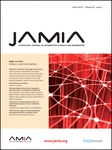
JOURNAL OF THE AMERICAN MEDICAL INFORMATICS ASSOCIATION
Transforming Healthcare with Cutting-Edge Informatics InsightsThe Journal of the American Medical Informatics Association, published by Oxford University Press, stands as a premier publication within the field of Health Informatics, showcasing cutting-edge research and innovative practices. With an impressive Q1 category ranking in 2023 and a remarkable Scopus rank of #6 out of 138, this journal consistently contributes to the advancement of knowledge and application in medical informatics, making it a vital resource for researchers, healthcare professionals, and students alike. Since its inception in 1994, the journal has fostered interdisciplinary collaboration and provides a platform for high-quality research that drives improvements in healthcare practices and technology. Although it operates on a subscription model, the journal's impactful findings and comprehensive analyses are essential for those looking to stay at the forefront of health informatics innovations.
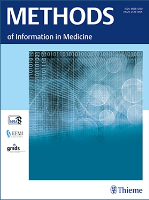
METHODS OF INFORMATION IN MEDICINE
Pioneering Research for the Future of Healthcare Delivery.METHODS OF INFORMATION IN MEDICINE, published by Georg Thieme Verlag KG, stands at the forefront of medical knowledge dissemination, pushing the boundaries of Advanced and Specialized Nursing, Health Informatics, and Health Information Management. Established in 1962, this prestigious journal has continuously evolved to address the dynamic landscape of healthcare and information technology, aiming to bridge the gap between clinical practice and innovative information technologies. With a robust impact factor reflected in its 2023 Scopus rankings, where it holds a commendable position in Q1 for Advanced Nursing, it serves as an invaluable resource for researchers, practitioners, and students alike. While it maintains a subscription-based access model, the journal fosters the exchange of pioneering methodologies and transformative ideas that are crucial for advancing healthcare delivery and improving patient outcomes. Explore the latest research, expert insights, and cutting-edge developments that solidify the journal’s role as a leader in the interdisciplinary approach to medicine and information systems.
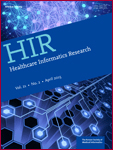
Healthcare Informatics Research
Empowering research to transform healthcare systems globally.Healthcare Informatics Research, published by the Korean Society of Medical Informatics, is a leading open access journal that has been advancing the field of healthcare informatics since its inception in 2010. With an ISSN of 2093-3681 and E-ISSN of 2093-369X, the journal provides a vital platform for disseminating high-quality research aimed at improving healthcare systems through innovative informatics solutions. Recognized for its contributions, it holds a Q2 rank in Biomedical Engineering and Q3 rankings in both Health Informatics and Health Information Management for 2023, reflecting its stature within the academic community. The journal is committed to open access, ensuring that research is freely accessible to researchers, professionals, and students worldwide, thus promoting knowledge sharing and collaboration. Located in the dynamic city of Seoul, South Korea, the journal serves as a hub for groundbreaking studies that impact health systems globally, making it an essential resource for those at the forefront of healthcare technology and management.

Journal of Healthcare Informatics Research
Bridging technology and healthcare for better outcomes.The Journal of Healthcare Informatics Research, published by SPRINGERNATURE, serves as a premier platform for the dissemination of innovative research and insights at the intersection of healthcare and information technology. Established in 2017 and operating out of Switzerland, this journal covers a broad scope encompassing Artificial Intelligence, Computer Science Applications, Health Informatics, and Information Systems, achieving a Q1 ranking across these fields in 2023. Notably, it ranks impressively within Scopus, holding positions in the top percentages across various categories, including 12th in Health Informatics. With an unwavering commitment to fostering advancements in healthcare through informatics, this journal is designed for researchers, professionals, and students alike, providing open access to significant findings and methodologies that drive the future of health technology. As the field evolves, the Journal of Healthcare Informatics Research stands as a vital resource for those dedicated to improving patient outcomes and operational efficiencies through data-driven strategies.
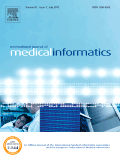
INTERNATIONAL JOURNAL OF MEDICAL INFORMATICS
Integrating Knowledge for Enhanced Medical PracticesInternational Journal of Medical Informatics, published by Elsevier Ireland Ltd, is a premier peer-reviewed journal dedicated to advancing the field of health informatics. Established in 1997, this journal has consistently strived to disseminate high-quality research and innovative practices, now recognized in the Q1 quartile of health informatics for 2023, ranking impressively at #24 out of 138 in Scopus. The journal's focus encompasses the integration of computer science and information technology in healthcare, fostering discussions on data management, telemedicine, health information systems, and decision support mechanisms. With an ISSN of 1386-5056 and E-ISSN of 1872-8243, it provides options for both subscription and open access, ensuring broad dissemination of research findings. As a vital resource for researchers, professionals, and students in the rapidly evolving domain of medical informatics, the International Journal of Medical Informatics is positioned to be at the forefront of knowledge translation in the health sector, contributing significantly to improvements in patient care and healthcare delivery.

Intelligent Medicine
Transforming healthcare through innovative AI insights.Intelligent Medicine, published by Elsevier, is a leading open-access journal dedicated to advancing the fields of Artificial Intelligence, Biomedical Engineering, Health Informatics, and related areas within Medicine. Since its inception in 2021, it has quickly established itself among the top tier of academic publications, holding a commendable Q2 ranking in several categories, including a rank of #51 in Health Informatics and #104 in Medicine (Miscellaneous) as of 2023. The journal aims to disseminate innovative research that harnesses AI technologies to improve healthcare outcomes, bridging the gap between cutting-edge technology and medical practice. With its open-access model, Intelligent Medicine ensures broad dissemination of research findings, facilitating collaboration and knowledge sharing among researchers, practitioners, and students globally. Located in Amsterdam, Netherlands, this journal plays a pivotal role in shaping the future of intelligent healthcare solutions, inviting submissions that push the boundaries of conventional medicine through creative and impactful research.